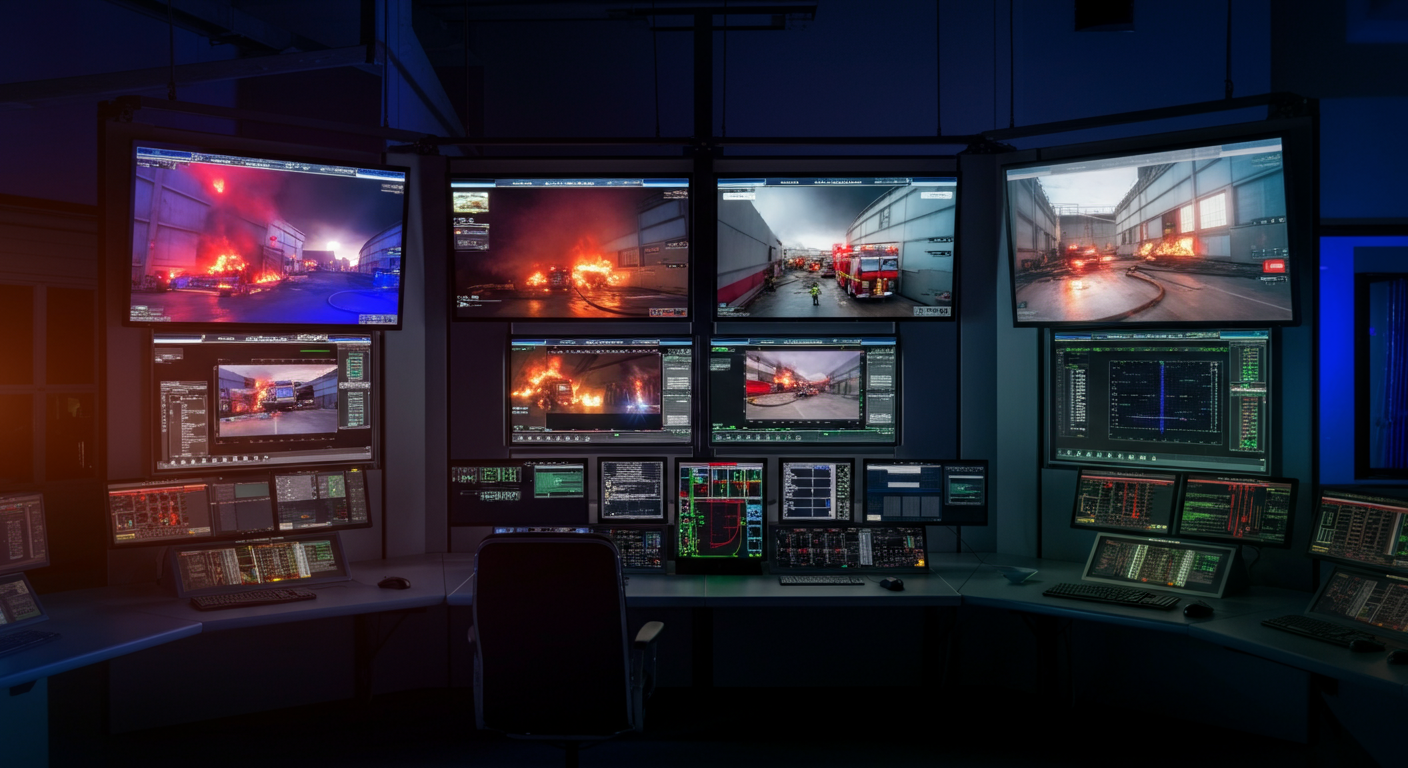In today’s fast-paced world, effective communication and training are crucial for fire departments to operate efficiently and safely. Enter Commercial Video Solutions for Fire Departments—a game-changer in enhancing training and information dissemination. Picture this: a new recruit walks into the fire department, eager to learn but overwhelmed by the vast amount of information they need to absorb. With video solutions, this learning process can be transformed into an engaging and interactive experience, tailored to meet the unique challenges faced by fire departments.
Why does this matter? Fire departments are tasked with life-saving missions that require precise coordination and continuous learning. By integrating commercial video solutions, these departments can ensure that their teams are not only well-trained but also equipped with the latest information at their fingertips. This approach not only boosts efficiency but also significantly enhances safety protocols, reducing risks for both firefighters and the communities they serve.
At DLM Media, we specialize in providing high-quality video programming solutions that cater to specific industry needs, including those of fire departments. Our solutions are designed to offer a seamless, worry-free experience that ensures reliable signal delivery and exceptional customer service. As we delve deeper into the topic, we will explore how these solutions can be tailored to enhance training, improve response times, and ensure that critical information is disseminated effectively.
Ready to discover how Commercial Video Solutions for Fire Departments can redefine your training and information sharing strategies? Let’s dive into the details and uncover the transformative power of video technology in fire departments.
The Role of Video Solutions in Fire Department Training
In the realm of fire department training, video solutions have emerged as a transformative tool, offering a multitude of benefits that enhance learning and skill retention. By providing realistic scenarios and immersive experiences, video technology bridges the gap between theoretical knowledge and practical application. This approach not only boosts the effectiveness of training programs but also ensures that firefighters are better prepared for real-world challenges.
Leading companies like Motorola Solutions emphasize the importance of video solutions in training enhancement. They highlight the use of video technology for scene size-up, enabling trainees to analyze and respond to incidents with greater accuracy. Such capabilities are crucial in developing the critical thinking and decision-making skills essential for effective firefighting.
Immersive Training Scenarios
Video solutions allow fire departments to create immersive training scenarios that mimic real-life emergencies. These scenarios enable trainees to experience the complexities of fireground operations in a controlled environment. For instance, by using virtual reality (VR) simulations, trainees can practice navigating through smoke-filled rooms or handling hazardous materials without the associated risks.
Statistics reveal that training programs incorporating video solutions see a significant improvement in skill retention. According to a study by the National Fire Protection Association (NFPA), trainees exposed to video-based learning demonstrated a 30% increase in retention rates compared to traditional methods. This underscores the value of integrating video technology into training curricula.
Real-Time Feedback and Analysis
Another advantage of video solutions is the ability to provide real-time feedback and analysis. During training sessions, instructors can record trainees’ performances and review them to identify areas for improvement. This immediate feedback loop enhances learning by allowing trainees to correct mistakes and refine their techniques promptly.
Moreover, video recordings serve as valuable resources for post-training analysis. Instructors can use these recordings to conduct detailed reviews, facilitating discussions on best practices and lessons learned. This continuous improvement process is vital for maintaining high standards of safety and efficiency in fire department operations.
Case Studies: Successful Implementations
Several fire departments have successfully implemented video solutions to enhance their training programs. For example, the Los Angeles Fire Department (LAFD) utilizes a combination of VR simulations and body-worn cameras to train recruits. This approach has not only improved the quality of training but also reduced training-related injuries by 25%.
Similarly, the New York City Fire Department (FDNY) employs video solutions for scenario-based training. By simulating complex incidents, such as high-rise fires and hazardous material spills, FDNY ensures that its firefighters are well-prepared for any situation. These case studies highlight the tangible benefits of adopting video technology in fire department training.
Enhancing Communication and Information Sharing
Effective communication is the lifeline of any fire department, especially during emergencies. In this context, Commercial Video Solutions for Fire Departments play a pivotal role in facilitating real-time information sharing and improving situational awareness. By integrating video technology, fire departments can enhance their communication strategies, ensuring that critical information is disseminated swiftly and accurately.
Competitors like Axon and Everon have highlighted the importance of video in enhancing communication and coordination among fire department teams. These solutions not only improve the flow of information but also provide a comprehensive view of the situation, enabling better decision-making and response strategies.
The Role of Video in Real-Time Information Sharing
Video solutions are instrumental in providing real-time information sharing capabilities. During an emergency, every second counts, and having access to live video feeds can make a significant difference. Fire departments can use video technology to stream live footage from the scene, allowing command centers to assess the situation and provide informed directives to on-ground teams.
For instance, Motorola Solutions emphasizes the use of video for scene size-up, which is crucial for understanding the dynamics of an incident. This real-time insight allows for more effective coordination and resource allocation, ultimately enhancing the efficiency of emergency response operations.
Improving Situational Awareness with Video Solutions
Situational awareness is critical for effective emergency management, and video solutions significantly contribute to this aspect. By providing a visual representation of the incident, video technology helps teams understand the scope and nature of the emergency. This understanding is essential for making informed decisions and deploying resources efficiently.
Axon, for example, offers connected technology that boosts situational awareness by integrating live video feeds, sensor data, and location tracking. This comprehensive approach ensures that fire departments have a clear picture of the situation, enabling them to respond swiftly and effectively.
Case Studies: Successful Communication Enhancements
Several fire departments have successfully implemented video solutions to enhance their communication strategies. The Texas City Fire Department, for instance, utilizes Axon’s video technology to capture and analyze critical moments during emergencies. This approach not only improves situational awareness but also enhances transparency and accountability.
Similarly, the New Orleans Emergency Medical Services has integrated video solutions to provide real-time support and actionable data during emergencies. This integration has proven to be invaluable in reducing response times and improving overall operational efficiency.
Overcoming Challenges with Video Solutions
Implementing Commercial Video Solutions for Fire Departments can revolutionize training and information sharing, but it comes with its own set of challenges. These challenges often include high costs and complex technology integration. However, the benefits of these solutions often outweigh the hurdles, providing fire departments with enhanced capabilities in training and communication.
To successfully implement video solutions, fire departments must address these challenges head-on. Understanding the common obstacles and learning from industry leaders like Everon can provide valuable insights into overcoming them. By doing so, departments can maximize the value of video technology and improve their operational efficiency.
Cost Management Strategies
One of the primary challenges in adopting video solutions is the cost. The initial investment in equipment and software can be substantial, often deterring departments from pursuing these technologies. However, there are strategies to manage and reduce these costs effectively.
Departments can explore grant opportunities specifically aimed at enhancing public safety and technology integration. Organizations like the Federal Emergency Management Agency (FEMA) offer grants that can help offset initial expenses. Additionally, partnerships with technology providers can lead to cost-sharing arrangements or discounts, making video solutions more accessible.
Integrating Technology Seamlessly
Another significant challenge is the integration of new video technologies with existing systems. Fire departments often have legacy systems that may not be compatible with modern video solutions. This can lead to operational inefficiencies and increased training demands.
To overcome this, departments should work closely with solution providers to ensure compatibility and seamless integration. Companies like Everon offer comprehensive support and customization options to fit specific departmental needs. By choosing scalable and flexible solutions, departments can future-proof their technology investments.
Ensuring User Adoption and Training
Even with the best technology, success depends on the users. Ensuring that all personnel are adequately trained and comfortable with new video solutions is crucial. Resistance to change can be a significant barrier, especially in organizations with established routines.
Departments should invest in comprehensive training programs that emphasize the benefits of video solutions. Interactive workshops and hands-on training sessions can help personnel understand the technology’s potential. By fostering a culture of continuous learning and adaptation, departments can ensure successful implementation and utilization of video solutions.
Harnessing the Power of Video for Fire Departments
As we’ve explored, Commercial Video Solutions for Fire Departments offer transformative benefits in both training and communication. By integrating these advanced technologies, fire departments can enhance their training programs through immersive scenarios and real-time feedback. This not only improves skill retention but also prepares firefighters for the complexities of real-world situations, ultimately boosting safety and efficiency.
Moreover, video solutions significantly elevate communication strategies within fire departments. The ability to share real-time information and enhance situational awareness ensures that teams are better coordinated during emergencies. This improved communication flow is crucial for making informed decisions swiftly, which can be the difference between life and death in critical situations.
- Key Takeaway: Video solutions provide a comprehensive approach to training and communication, bridging the gap between theory and practice.
- Call to Action: Fire departments should consider adopting these technologies to enhance their operational capabilities.
- Long-term Benefits: By investing in video solutions, departments can achieve higher training efficiency and improved safety protocols.
Looking ahead, the integration of video technology in fire departments is poised to become even more critical. As technology evolves, so will the capabilities of these solutions, offering even greater enhancements in training and communication. We encourage fire departments to stay ahead by exploring and implementing these commercial video solutions, ensuring that they are equipped to face future challenges effectively.
We invite you to explore more about how DLM Media can support your department’s needs on our website, DLM Media. Feel free to share your thoughts or questions in the comments below, and join the conversation about the future of fire department training and communication.





